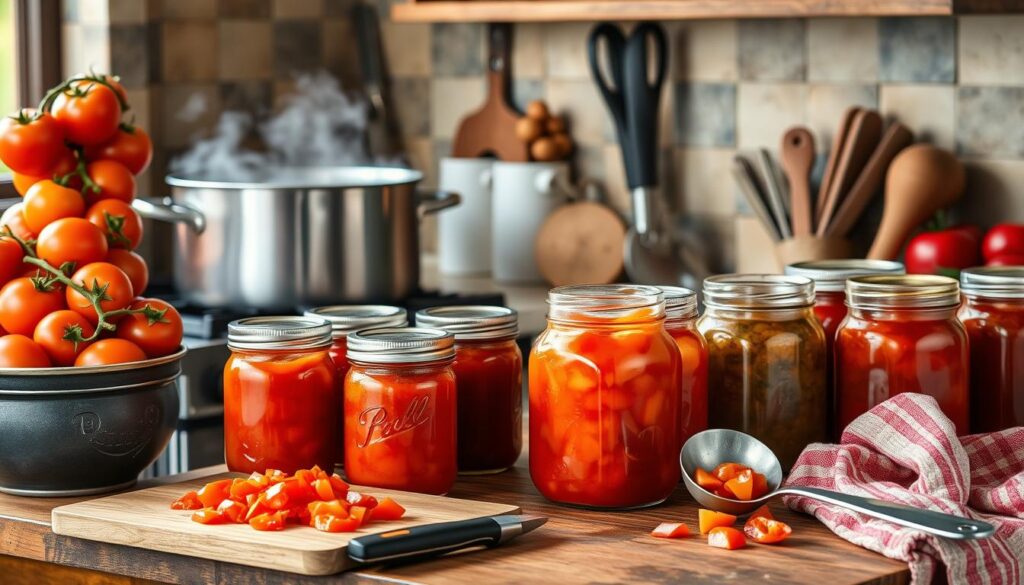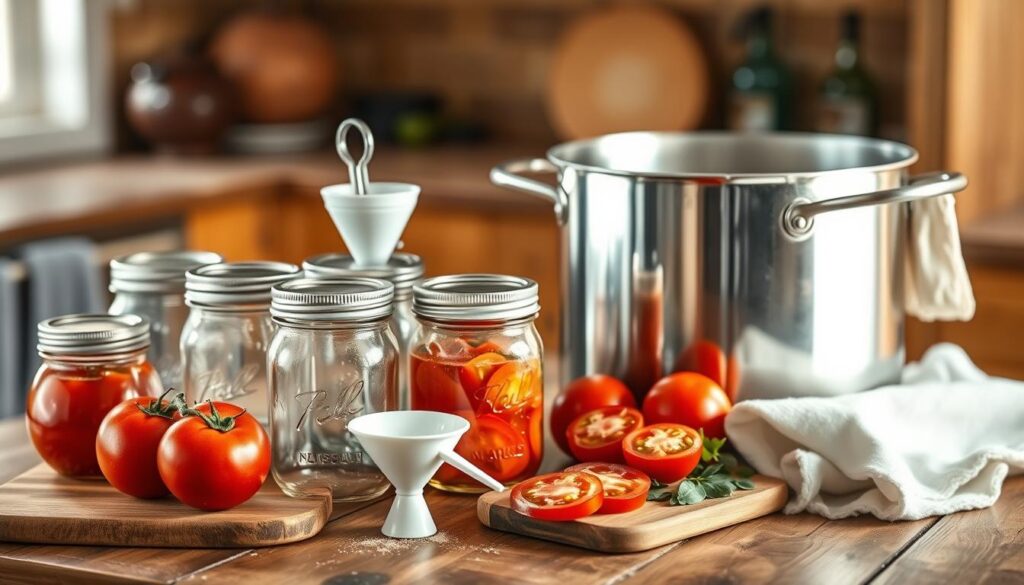Did you know it takes about 1¼ to 1½ pounds of ripe tomatoes for each pint of canned tomatoes? Preserving tomatoes at home is more than just a hobby. It’s a way to enjoy summer’s flavors all year and save money. This guide will help you can tomatoes safely and effectively.
Whether you use a boiling water canner or a pressure canner, you’ll discover new ways to cook. Mastering tomato preservation can transform your meals.

Table of Contents
Key Takeaways
- Learn the necessary quantities of tomatoes needed for canning.
- Canning tomatoes allows you to enjoy homemade flavors throughout the year.
- Understanding acidity is essential for safe canning practices.
- Various methods exist for preserving tomatoes, including water bath and pressure canning.
- Canning at home can save you money compared to store-bought options.
Understanding Tomato Types for Canning
Choosing the right tomatoes is key for canning. Some varieties are better for flavor, texture, and canning. Knowing which tomatoes to pick can make your canned goods better.
Best Tomatoes for Canning
Look for Roma, San Marzano, and Amish Paste tomatoes for canning. Roma tomatoes are firm and have less moisture, great for canning. San Marzano tomatoes are sweet and hold up well in heat, perfect for summer. Amish Paste tomatoes are large and meaty, great for sauces.
Other good tomatoes for canning include:
- Pink Fang: It has less juice and more flesh, perfect for sauces.
- Paisano: A determinate variety that gives early harvests before summer heat.
- New varieties: Hungarian Heart, Opalka, and Pomodoro are being explored for canning.
Choosing Ripe and Unblemished Tomatoes
Make sure to pick ripe tomatoes without blemishes or rot. For a pint, you need about 1¼ to 1½ pounds of ripe tomatoes. For a quart, aim for 2½ to 3½ pounds. Always choose tomatoes that are fully ripe for better flavor and texture.
Using these tips will make your canning more rewarding. For more on using canned tomatoes, check out this roasted vegetables recipe.

Essential Supplies for Canning Tomatoes
Canning tomatoes needs special tools and supplies for safety and quality. The right equipment makes the process easier and more fun. Here are the essential canning supplies you need, like jars, a water bath canner, and other tools for a successful canning journey.
Canning Jars, Lids, and Bands
Choosing the right canning jars is key. Glass jars made for food preservation are safe and durable. You also need lids and bands to seal the jars well. Make sure to pick quality lids; avoid one-piece lids for safety reasons.
Standard jar sizes are pint and quart. They can hold about 1 quart of tomatoes from 2 1/2 to 3 1/2 pounds of fresh tomatoes. Check your jars for cracks or chips before filling. Brands like Ball offer reliable jars and accessories.
Using a canning jar lifter like the Ball Secure-Grip can make lifting jars easier and safer.
Water Bath Canner and Equipment
The water bath canner is crucial for processing tomatoes. It should be at least 4 to 5 inches deeper than your jars. A 12-inch depth is best for quart jars. This ensures the jars are fully submerged for even heating.
If you don’t have a water bath canner, a large stockpot can work. It should be at least 12 quarts and tall enough for your jars. A 5-quart colander is handy for preparing tomatoes. Keep your home canning tools organized for a smoother process.

Preparing Your Tomatoes for Canning
Preparing tomatoes for canning is key for safety and flavor. Start with the right preparation and tools. This part covers cleaning canning jars and how to peel tomatoes and dicing tomatoes for canning.
Cleaning and Sterilizing Jars
First, clean your canning jars well. Use hot, soapy water to wash jars, lids, and rims. Make sure to remove all residues from previous uses.
After washing, sterilize jars to avoid contamination. Simmer jars in boiling water for about 10 minutes. This step also warms the jars for filling with hot tomatoes.
Peeling and Dicing Tomatoes
Now, prepare your tomatoes. The best way to peel tomatoes is by blanching them. Boil them for 30 seconds to 1 minute to loosen the skin.
Then, quickly put the tomatoes in an ice water bath. This stops the cooking and makes peeling easier.
Next, dice tomatoes for canning. Cut peeled tomatoes into quarters and remove any bad spots. You’ll need about 12 pounds of tomatoes for 4 quarts of canned product.
Once your tomatoes are ready, start canning. For detailed canning instructions, visit this resource.

How to Can Tomatoes: The Basics
Canning tomatoes is a rewarding task. It lets you keep your garden tomatoes fresh all year. You can use a boiling water canner or a pressure canner for tomatoes. Knowing how to use these tools is key to preserving your tomatoes at home.
Boiling Water Canner Overview
A boiling water canner is great for high-acid foods like tomatoes. It works by dipping jars in boiling water. This creates a seal and keeps bacteria out.
For canning tomatoes, quart jars need about 45 minutes at low altitudes. Pint jars take about 40 minutes. Adding 2 tablespoons of lemon juice per quart helps keep the tomatoes fresh and safe.

Pressure Canner Usage
Even though tomatoes are acidic, sometimes you need a pressure canner. This is true when tomatoes are mixed with other foods that aren’t as acidic. A pressure canner uses higher heat to kill off bad bacteria.
At sea level, quart jars need about 85 minutes in a pressure canner. Always check the jar seals after they cool down. This is important for keeping your canned tomatoes good.
| Canning Method | Processing Time (Quarts) | Processing Time (Pints) | Acidity Maintenance |
|---|---|---|---|
| Boiling Water Canner | 45 minutes | 40 minutes | Add 2 tbsp of lemon juice per quart |
| Pressure Canner | 85 minutes | N/A | Adjust per recipe requirements |
Learning these basic canning methods helps you make delicious, safe tomatoes. You can enjoy them all year in your cooking.
Step-by-Step Canning Process
When you start canning, every detail matters, especially when filling jars. Each step is key to keeping your tomatoes safe and tasty. Here’s how to fill jars, add acidity, and get the right headspace.
Filling the Jars with Tomatoes
Begin by blanching your tomatoes to make their skins easy to remove. Boil them for 30 to 60 seconds, then cool them in ice water. This works best for tomatoes like Roma.
When you fill the jars, pack the tomatoes tightly. This helps keep the juice in and air out.
Adding Acid: Why Lemon Juice is Important
Adding acidity is crucial for canning tomatoes safely. Each quart jar needs 2 tablespoons of lemon juice or ½ teaspoon of citric acid. This step stops bacteria from growing and makes the tomatoes taste better.
You can also add salt for extra flavor. Use 1 teaspoon per quart, but it’s not required.
Ensuring Proper Headspace
It’s important to have a ½ inch headspace in your jars. This helps the lid seal properly and prevents spills during processing. Don’t add extra water when packing raw tomatoes.
Instead, let the tomatoes’ natural juice fill the jar. This keeps the acidity right and helps preserve the tomatoes well, whether you use pressure canning or water bath canning.
Processing Your Jars
Processing jars is key to canning tomatoes safely and well. It involves following specific timing and temperature rules. This ensures your food stays safe and tastes great. Whether you use a boiling-water bath or a pressure canner, focus on this step for good seals and long storage.
Timing and Temperature Guidelines
For different jar sizes, exact processing times are needed:
| Process Type | Jar Size | Processing Time | Pressure (PSI) |
|---|---|---|---|
| Boiling-Water Bath | Pints & Quarts | 90 minutes | N/A |
| Dial-Gauge Pressure Canning | Pints & Quarts | 25 minutes at 11 PSI | 11 PSI |
| Weight-Gauge Pressure Canning | Pints & Quarts | 25 minutes at 15 PSI | 15 PSI |
For effective processing, keeping the right temperature is crucial. In boiling-water bath canning, keep the water simmering. For pressure canning, use the correct PSI for your method.
Cooling and Sealing the Jars
After processing, cool the tomatoes carefully. Place jars on a clean towel or rack, allowing air to circulate. A distinct snap or pinging sound means a vacuum seal has formed.
To check the seal, gently tap the lid after cooling. If it doesn’t move, it’s sealed. Also, look for a slight concave shape on the lid. This confirms a secure seal. Proper sealing is essential for safe storage of your canned tomatoes for up to two years or more.
Storage Tips for Canned Tomatoes
Storing your canned tomatoes right is key to keeping their taste and quality. Knowing the best storage conditions can make your canned tomatoes last longer. This way, you can enjoy them for months.
Optimal Storage Conditions
Here are some tips for storing canned tomatoes:
- Temperature: Store them in a cool, dark spot. The best temperature is between 50°F and 70°F.
- Light Exposure: Don’t let them sit in direct sunlight. Sunlight can damage the cans and affect the taste.
- Humidity Levels: Keep the humidity low. This prevents rust and mold on the cans.
Following these tips will help keep your canned tomatoes fresh and safe to use all year.
How Long Do Canned Tomatoes Last?
The shelf life of canned tomatoes depends on how you store them and the canning method. Generally, they can last:
- Up to 1 year for the best taste when stored properly.
- 2 to 3 years for safety, but the quality might drop after a year.
Always check for signs of spoilage before using them. Look for bulging lids, rust, or an unusual smell. These signs mean the tomatoes might not be safe to eat.
Canned Tomato Recipes
Canned tomatoes are a great addition to many dishes. They save time and add flavor. Here are some tasty ideas to make your meals better with these versatile ingredients.
Using Canned Tomatoes in Sauces and Soups
For a classic dish, try making tomato sauces for pasta. Choose high-quality canned tomatoes for vibrant sauces. For a hearty meal, make a chili with your favorite beans and spices.
For a cozy meal, make a tomato soup. It’s quick to make with canned tomatoes. Try this Italian sausage soup for a unique flavor.
Creative Ways to Include Canned Tomatoes in Meals
Canned tomatoes are great for more than just sauces. Add them to stir-fries, casseroles, or breakfast dishes like shakshuka. They balance out richer flavors.
- Enhance your pizza sauce by blending canned tomatoes with garlic, oregano, and basil.
- Create a refreshing salsa or dip using diced canned tomatoes mixed with jalapeños and cilantro.
- Prepare a nutritional boost in stews; simply add canned tomatoes for depth and richness.
Try tomato soup recipes or use canned tomatoes in creamy tomato risotto. The possibilities are endless, showing how canned tomatoes fit into any cooking style.
Common Canning Mistakes to Avoid
Canning is a great way to keep your harvest fresh. But, there are common mistakes that can spoil your food or make it unsafe. Knowing about these mistakes, like sealing problems and how to fill jars right, can make your canning better.
Ensuring Proper Seals
Getting your jars to seal well is key to avoiding spoilage. Mistakes in sealing can let bacteria in, which is bad. Look for signs like a popped lid or a wobbly lid. If you see these, you might need to reprocess or use the jars right away.
Avoiding Overfilling and Underfilling
Getting the right amount in your jars is crucial. Too much liquid can cause problems during processing, like bad seals. Too little can also cause issues, like not sealing properly. Stick to the recommended amount to avoid these problems. This will help keep your jars safe and tasty.
| Canning Mistake | Consequences | Solution |
|---|---|---|
| Improper Seals | Potential spoilage and contamination | Check seals after processing; reprocess failing seals |
| Overfilling Jars | Liquid loss; improper seals | Leave appropriate headspace as recommended |
| Underfilling Jars | Risk of headspace issues; spoilage | Follow guidelines for correct filling levels |
| Not Following Processing Times | Improperly preserved food | Use timers accurately; adjust for altitude changes |
Benefits of Canning Tomatoes at Home
Canning tomatoes at home is both practical and fulfilling. It saves money and captures the essence of tomatoes. This way, you can enjoy fresh flavors all year and keep your food safe and healthy.
Cost Savings and Convenience
Home canning is a big money-saver. It’s cheaper than buying canned tomatoes, especially when they’re out of season. For example, you can get about nine bushels of tomatoes in the summer. This is a great way to save for the future.
Canning is also super convenient. With a few hours of work, you can make jars of fresh tomatoes that last a year. This makes planning meals easier and adds flavor to your dishes.
Preserving Freshness and Flavor
Home canning keeps tomatoes tasting great. Commercial methods can lose flavor. But, by canning at home, you control the cooking process. This ensures your tomatoes are always flavorful.
With over 3,000 heirloom varieties, you can pick the perfect tomatoes for your taste. Plus, following safe canning practices makes it safe and fun. Check out this guide for more on safe tomato preservation.
Home canning offers many benefits. It’s good for your wallet and keeps tomatoes tasting fresh. Learn more about safe canning in this guide.
| Method | Process Time (Pint) | Process Time (Quart) | Liquid Ratio |
|---|---|---|---|
| Hot-Packing | 40 minutes | 45 minutes | Higher solids ratio |
| Raw-Packing | 40 minutes | 45 minutes | Higher liquid ratio |
Canning Tips for Beginners
Starting your canning journey is exciting but can feel overwhelming. Simple steps can help you have a successful first try. Focus on learning the basics and improving your skills. Remember, every expert started as a beginner. Here are some valuable tips to help you along the way.
Simple Steps for a Successful First Attempt
Begin by picking ripe, unblemished tomatoes. Proper preparation is key. Use these canning tips to make your experience better:
- Prepare your work area: Clean surfaces and gather all necessary supplies, including canning jars, lids, and a water bath canner.
- Boil water for skin loosening: Place tomatoes in boiling water for about 30 seconds. This makes peeling easier.
- Sterilize jars: Boil jars in water for 10 minutes before you fill them to ensure safety and quality.
- Headspace matters: Keep a ½ inch of headspace at the top of each jar when adding diced tomatoes. This prevents overflow during processing.
- Add acid: Include 2 tablespoons of commercially canned lemon juice per quart-sized jar for safety.
- Canning time: Process quarts for 45 minutes and pints for 40. Adjust for elevation if necessary.
- Cooling period: Allow jars to cool for at least 2 hours before handling. Look for the popping sound indicating proper sealing.
- Check the seal: Ensure the jar holds tightly when lifted by the lid after 24 hours. This signifies a successful seal.
Resources for Further Learning
To improve your canning skills and gain confidence, check out these resources:
- Books on home preserving techniques offer in-depth knowledge.
- Online tutorials can provide visual guidance.
- Local canning workshops connect you to seasoned canners.
With patience and practice, mastering these beginners canning tips will lead to a fruitful canning experience. Remember that successful canning is achievable with preparation and the right techniques.
Conclusion
Canning tomatoes is a way to keep summer’s flavors alive all year. It’s not just about storing food; it’s a way to connect with nature. It also lets you enjoy your own produce for months.
By following safe canning methods, your tomatoes will stay tasty and safe. You can use a pressure canner or the water bath method. This way, you can make meals with your own ingredients all year.
Canning tomatoes also reduces food waste and makes meals more flavorful. So, start canning tomatoes to fill your pantry with delicious food. You’ll save money and enjoy the process.
F.A.Q
What is the best way to can tomatoes?
To can tomatoes, use boiling-water canning or pressure canning. Choose Roma or paste tomatoes for their low moisture. Clean and prepare them well. Follow step-by-step instructions for filling jars, adding acid, and processing.
How many tomatoes do I need for canning?
For a pint jar, use 1¼ to 1½ pounds of ripe tomatoes. For a quart jar, use 2½ to 3½ pounds. Pick ripe and unblemished tomatoes for the best quality.
What supplies do I need for canning tomatoes?
You’ll need glass jars, lids, and bands for canning. Also, a water bath canner or pressure canner, and basic tools like a ladle and funnel. Sterilize your jars before use.
How do I prepare tomatoes for canning?
Clean the tomatoes well. Blanch them in boiling water to peel the skins. Cool them in ice water. Then, peel and dice the tomatoes for filling jars.
What can I do if I don’t have a water bath canner?
Use a large pot with a lid if you don’t have a water bath canner. Place a rack or towel at the bottom. Make sure the water covers the jars by at least an inch.
Why is it important to add lemon juice when canning tomatoes?
Bottled lemon juice increases the tomatoes’ acidity. This is key for safe preservation. It prevents bacteria growth and keeps your canned goods safe.
How can I tell if my canned tomatoes have spoiled?
Look for bulging lids, leakage, unusual odors, and discoloration. If you see these signs, don’t eat the tomatoes. They might be unsafe.
What are some common mistakes to avoid when canning tomatoes?
Avoid not checking seals, overfilling or underfilling jars, and using unripe or damaged tomatoes. Follow processing times and headspace guidelines to avoid spoilage.
How long can I store canned tomatoes?
Canned tomatoes last 1 to 1.5 years in a cool, dark place. Quality may decrease over time. It’s best to use them within a year for the best flavor.
What recipes can I make with canned tomatoes?
Use canned tomatoes in soups, sauces, and stews. Try making chili, pizza sauce, or marinara sauce. They add rich, garden-fresh flavors to your dishes.



